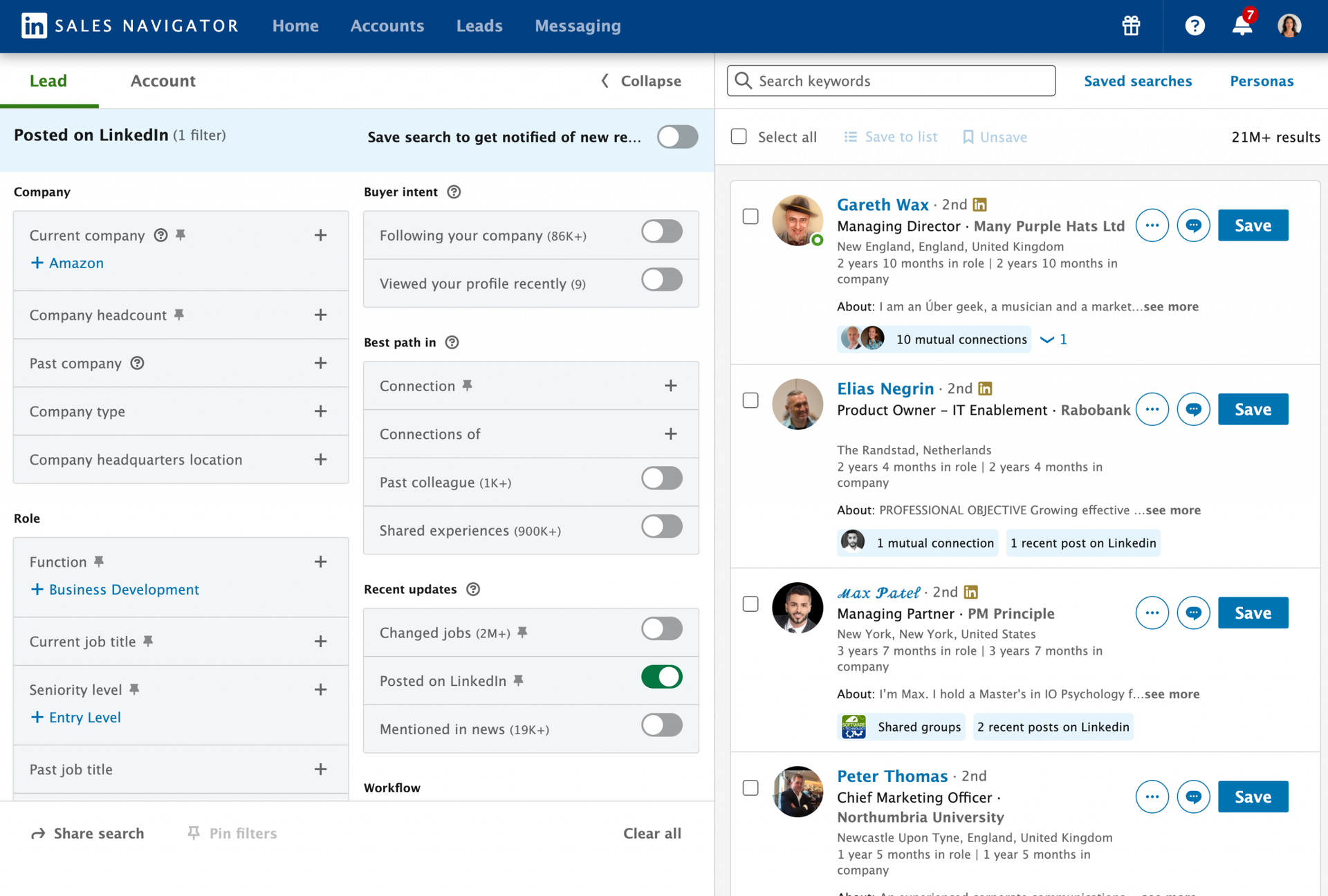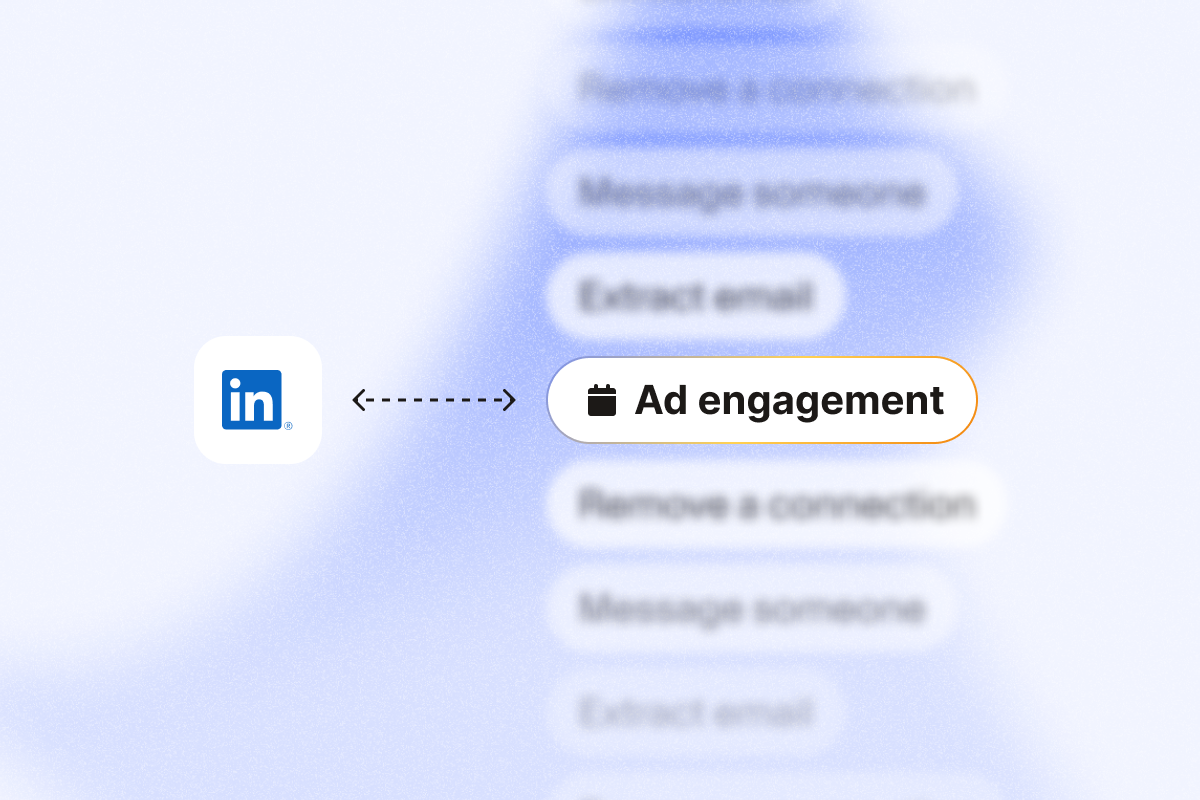Smart marketing and sales teams understand that LinkedIn stands apart from other social platforms. When someone likes or comments on your ad, they signal interest in the topic your solution covers, making them strong candidates for relevant, timely outreach.
PhantomBuster gives you a tested workflow to turn ad engagement into qualified leads and measurable pipeline growth. Let’s explore how you can stop wasting spend and start generating more high-quality leads from your LinkedIn advertising.
Why LinkedIn ad engagement converts better than generic traffic
When decision makers interact with your LinkedIn ads, they’re taking meaningful actions that indicate genuine interest. Unlike traditional ads or Google Ads that simply drive traffic to landing pages, LinkedIn engagement represents:
- High-value audience: 4 out of 5 LinkedIn members drive business decisions, and the platform’s audience has 2x the buying power of the average web user.
- Prospects already familiar with your value proposition: They’ve seen your message and engaged with it.
- Stronger intent signals: Ads on LinkedIn boost purchase intent by 33% and deliver a 2-3x lift in brand perception (per LinkedIn’s reported benchmarks).
- Prospects more receptive to conversation: They’re primed for relationship building rather than requiring a hard sales pitch.
- Leads that convert at higher rates: LinkedIn engagement intent drives better results than generic lead-form traffic.
- Better efficiency and ROI: With 2x higher conversion rates and 28% lower CPL, LinkedIn reports strong performance versus typical benchmarks for comparable channels.
PhantomBuster’s pre-built automations and AI-powered enrichment capture ad engagers, add company and contact data, and trigger personalized outreach, so reps start more relevant conversations, faster.
Step-by-step playbook: Convert LinkedIn ad engagement into pipeline growth
1. Identify target LinkedIn ads with engagement
First, find LinkedIn posts or ads with strong engagement (for example, 50+ reactions or 10+ comments) that match your ICP:
- Log into LinkedIn and locate relevant ads in your industry (your own paid campaigns or competitors’). Look for sponsored content or conversation ads with strong engagement metrics.
- Prioritize sponsored posts from your company pages that match your current campaign theme (e.g., “Sales automation for SaaS”) or high-engagement thought leadership from target accounts.
- When you find promising content with engagement, click the three dots and select “Copy link to post.”
This works for your own campaigns and for learning from adjacent audiences, always respecting LinkedIn’s policies and user preferences.
2. Extract engaged LinkedIn users
Next, use PhantomBuster to collect the LinkedIn users who engaged with the ad:
- Open PhantomBuster’s LinkedIn Post Likers Export automation and paste your ad’s post URL.
- Launch the automation to export the list of users who liked the post (subject to LinkedIn visibility limits).
- Repeat with PhantomBuster’s LinkedIn Post Commenters Export automation to collect commenters.
In this video walkthrough, one ad yielded 100+ likers and additional commenters, enough to start a focused outreach list. Results vary by audience size and spend.
3. Consolidate engager lists for account-based marketing
Now combine your engagement data into one comprehensive list for targeted sales outreach:
- Open your Leads workspace in PhantomBuster.
- Create a new list that filters for profiles processed by both automations.
- Name your list (e.g., “LinkedIn ad engagers”). This consolidated list becomes the foundation for your account-based marketing approach.
This creates a single list of high-intent prospects who engaged with your content, ideal for conversion-focused outreach.
4. Enrich profiles with valuable insights
To personalize at scale, enrich each profile with role, company, and contact data:
- Run PhantomBuster’s LinkedIn Profile Scraper Automation with your consolidated list of ad engagers as input.
- Turn on email discovery to find verified business emails where available. Use business emails only and follow local laws (CAN-SPAM, GDPR) and LinkedIn’s guidelines.
- Enable company enrichment so each record includes company size, industry, and title, fueling relevant targeting and message personalization.
- Launch the automation to collect detailed information on your prospects (as available).
This step transforms basic profiles into comprehensive data about decision makers in your target accounts, providing the foundation for personalized relationship building rather than generic sales pitches.
5. Automate LinkedIn outreach and maintain consistent engagement
With your enriched list of ad engagers, you’re ready to start meaningful conversations at scale:
- Use PhantomBuster’s LinkedIn Outreach Automation and select your enriched list as the source.
- Write a short connection request that references the ad topic (e.g., “Sales automation for SDRs”) rather than the specific engagement.
- Schedule follow-up messages with value-driven content to be sent after connections are accepted.
This playbook shows how to write follow-ups that reference the ad topic (not the action). For example: “Saw your interest in sales automation, happy to share frameworks we use with SDR teams.”
- Set daily limits that respect LinkedIn’s guidelines (for most teams, ~20 invitations per rep per day works reliably).
- Launch your automated outreach sequence to begin nurturing leads.
How to transform marketing and sales alignment with engagement data
Traditionally, ad campaigns and sales efforts operate in silos: marketing generates awareness, sales chases conversions, and valuable engagement signals get lost in between. PhantomBuster changes that dynamic entirely, creating powerful alignment between your marketing teams and sales teams.
Here’s how this workflow drives alignment between your teams:
- Connects paid campaigns directly to revenue outcomes: Instead of measuring ads purely on clicks or impressions, marketing can now attribute real pipeline impact by showing which engaged users actually entered the CRM and progressed through the funnel.
- Delivers pre-qualified, high-intent leads to sales: Engagement data reveals prospects who’ve already interacted with your brand, giving your sales team warmer leads and saving hours of cold outreach.
- Enables personalized follow-ups at scale: Each PhantomBuster-enriched lead includes title, company data, and recent activity so reps can start relevant conversations.
- Creates a feedback loop for refinement: As sales teams engage these leads, their conversion metrics flow back to marketing, refining ad targeting, messaging, and content strategy over time.
Together, these steps transform fragmented LinkedIn engagement into a full-funnel growth system. With native and no-code CRM integrations, qualified leads can sync from PhantomBuster into your pipeline and be tracked from first interaction through deal stages.
LinkedIn Sales Navigator: How to refine and prioritize this workflow
While this playbook works with standard LinkedIn, teams with LinkedIn Sales Navigator can further refine their approach by:
- Identifying additional engagement from key accounts: Filter and monitor activity from decision-makers across your ABM (Account-Based Marketing) list to catch new signals early.
- Gaining deeper industry and role insights: Use Sales Navigator’s 30+ advanced filters such as company headcount, growth stage, or seniority level to contextualize each prospect before outreach.

- Prioritizing high-value accounts: Combine PhantomBuster’s engagement data with Sales Navigator’s lead scoring and custom lists to focus on those most likely to convert.
- Capturing engagement from groups and company pages: Expand your net by tracking conversations and interactions across LinkedIn Groups and company updates tied to your niche.
Combining PhantomBuster’s automations with Sales Navigator insights creates a connected demand-generation workflow where ad engagements are captured and measured as steps toward pipeline. Your marketing team identifies the spark, and your sales team turns it into a relationship, closing the loop between awareness and revenue.
Start your 14-day free trial of PhantomBuster, no credit card required. Build a personalized pipeline from LinkedIn ads and start meaningful conversations quickly.
FAQ: LinkedIn Ad Engagement to Pipeline Growth
How does this strategy support account-based marketing?
This approach is ideal for ABM as it identifies specific decision makers from target accounts who are already showing interest. By capturing engagement with your thought leadership content, you can focus your team’s expertise on accounts showing genuine interest.
Can I use this approach with both LinkedIn and Google ads?
PhantomBuster’s workflow here uses LinkedIn data. While Google Ads drive traffic to landing pages, LinkedIn ads create visible engagement you can directly convert to conversations using this playbook. For other channels, connect your CRM or data sources via CSV or no-code connectors.
How many connection requests should my sales team send daily?
We recommend approximately 20 invitations per day per team member. This volume respects LinkedIn’s guidelines while generating a steady stream of new connections.
How should I personalize my outreach messages?
Reference the topic of the ad rather than the specific engagement. For example, “I saw you’re interested in sales automation…” rather than “I noticed you liked our ad.” The playbook includes message templates tailored by role and topic, so outreach feels relevant, not intrusive.
What’s the ideal timing for follow-up messages?
Send your first follow-up message one day after the connection is accepted, then schedule a second follow-up seven days later if needed.
Can I export these leads to my CRM system?
Yes. You can export to CSV or sync to CRMs like HubSpot using native or no-code connectors (e.g., Zapier, Make). This ensures your newly discovered leads move seamlessly into your existing workflows.
Do I need to manually run these automations every day?
No. The examples show manual runs, but you can schedule automations to keep lists fresh and messages sending on your cadence.
